Luận án Synergic effect of cassava (manihot esculenta crantz) foliage, brewer’s grains, and biochar on methane production and performance of ruminants
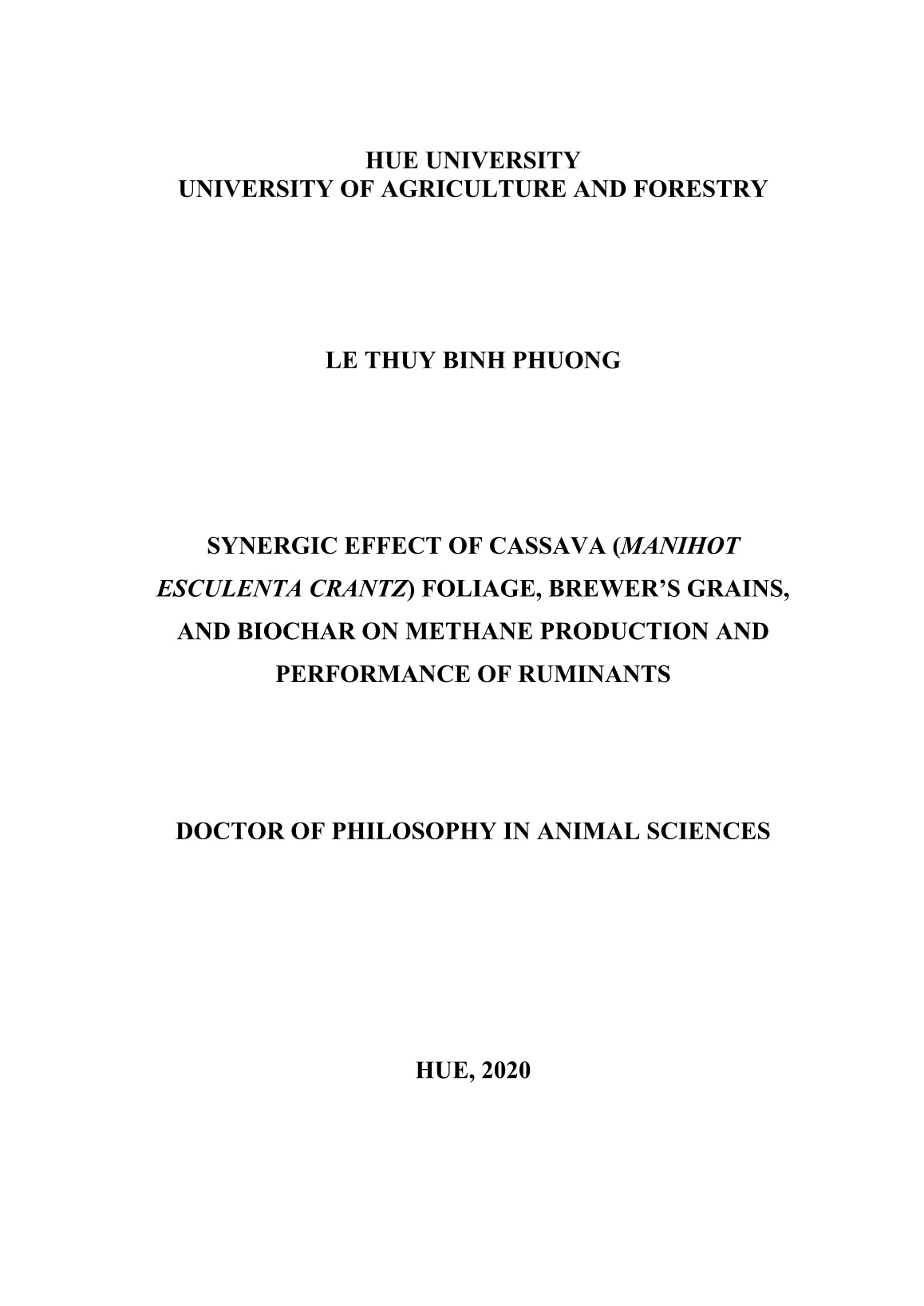
Trang 1
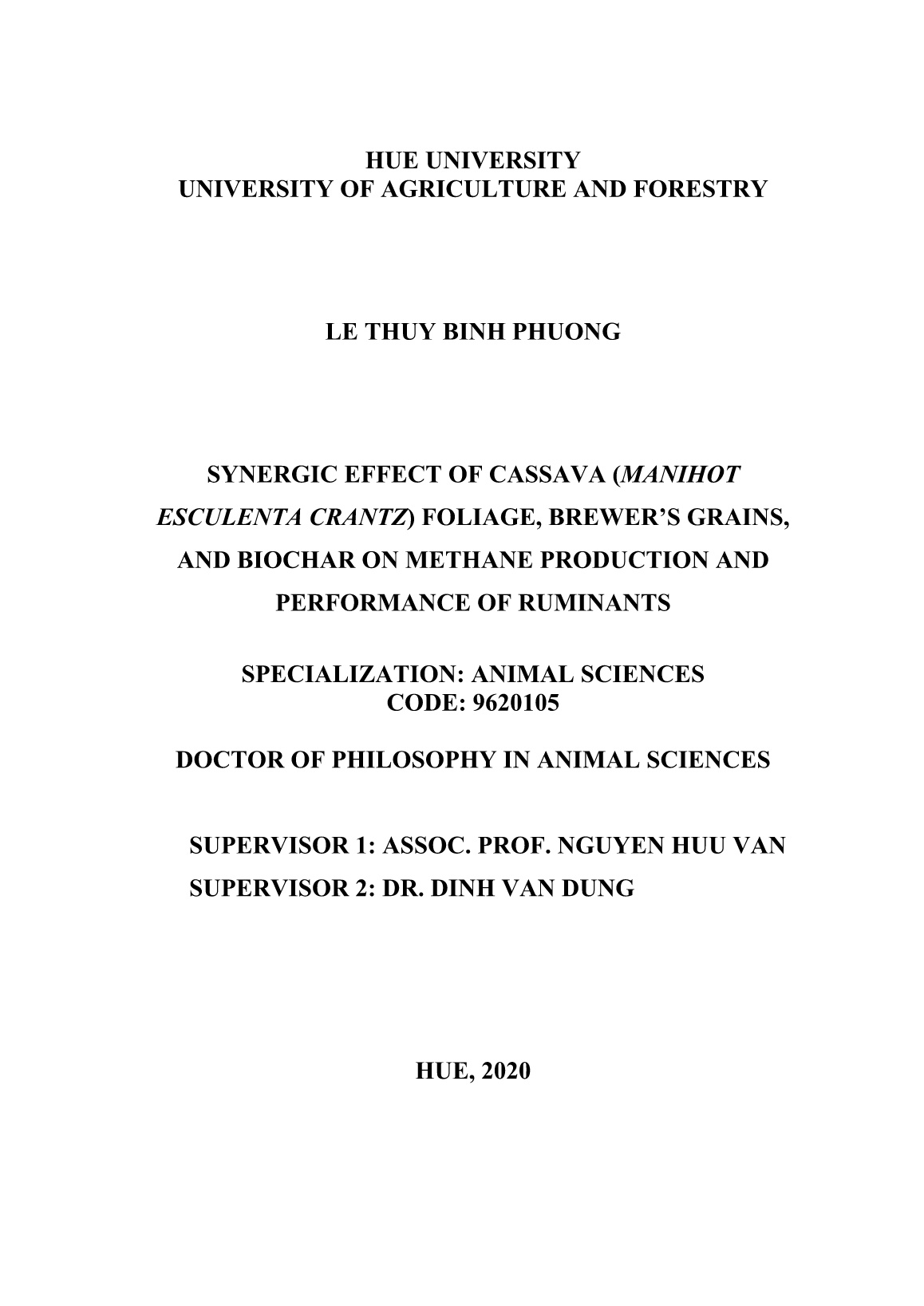
Trang 2
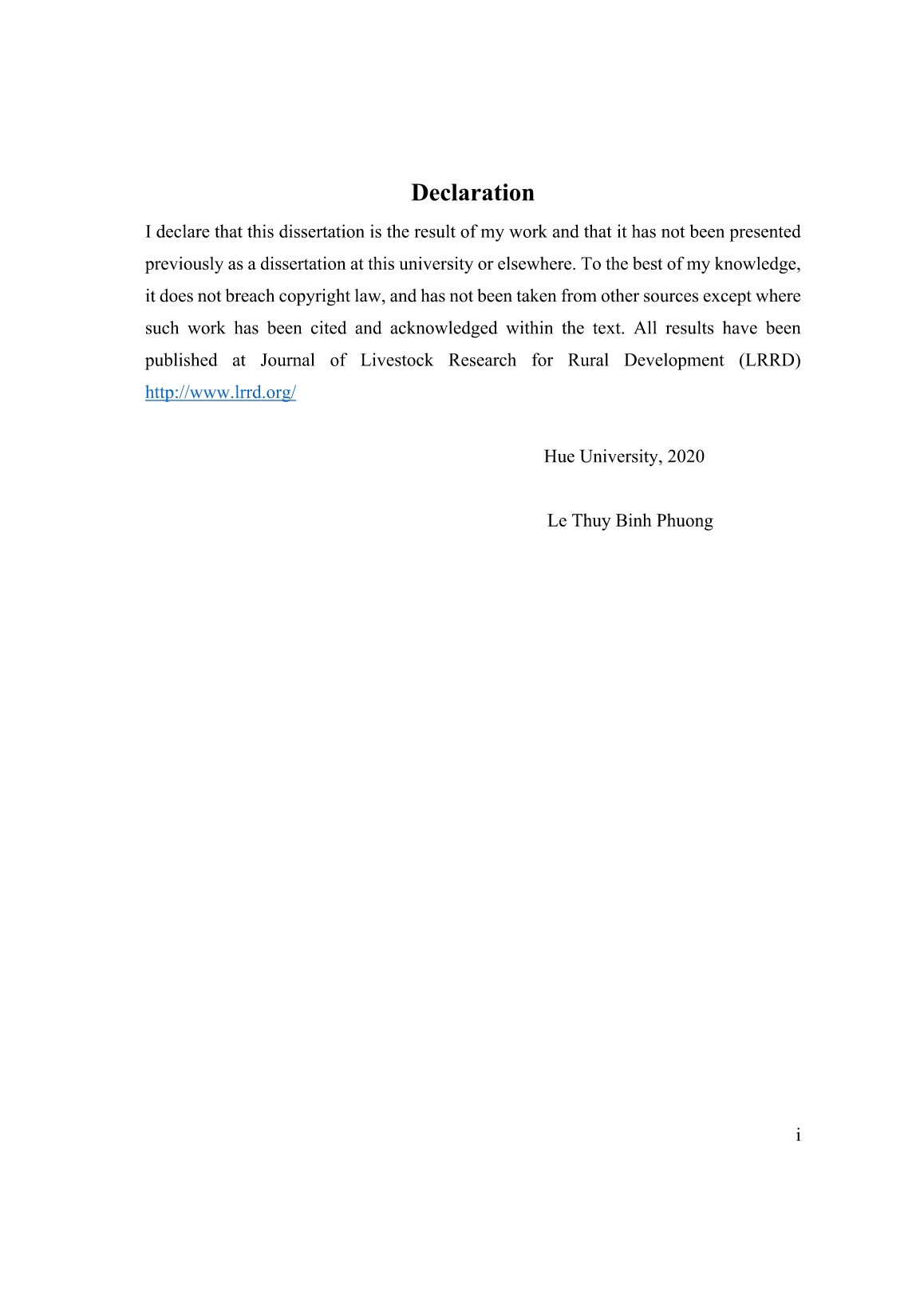
Trang 3

Trang 4
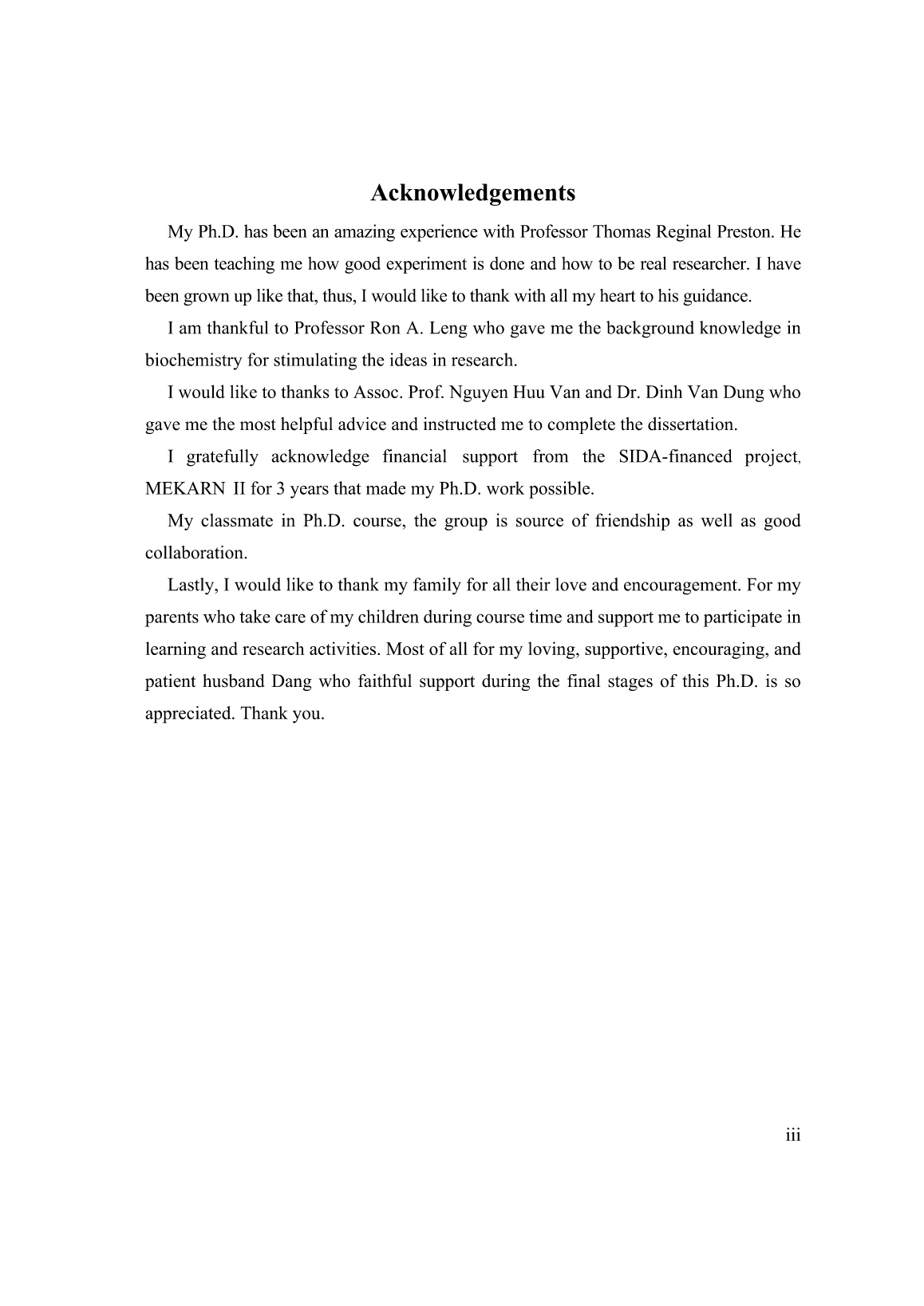
Trang 5
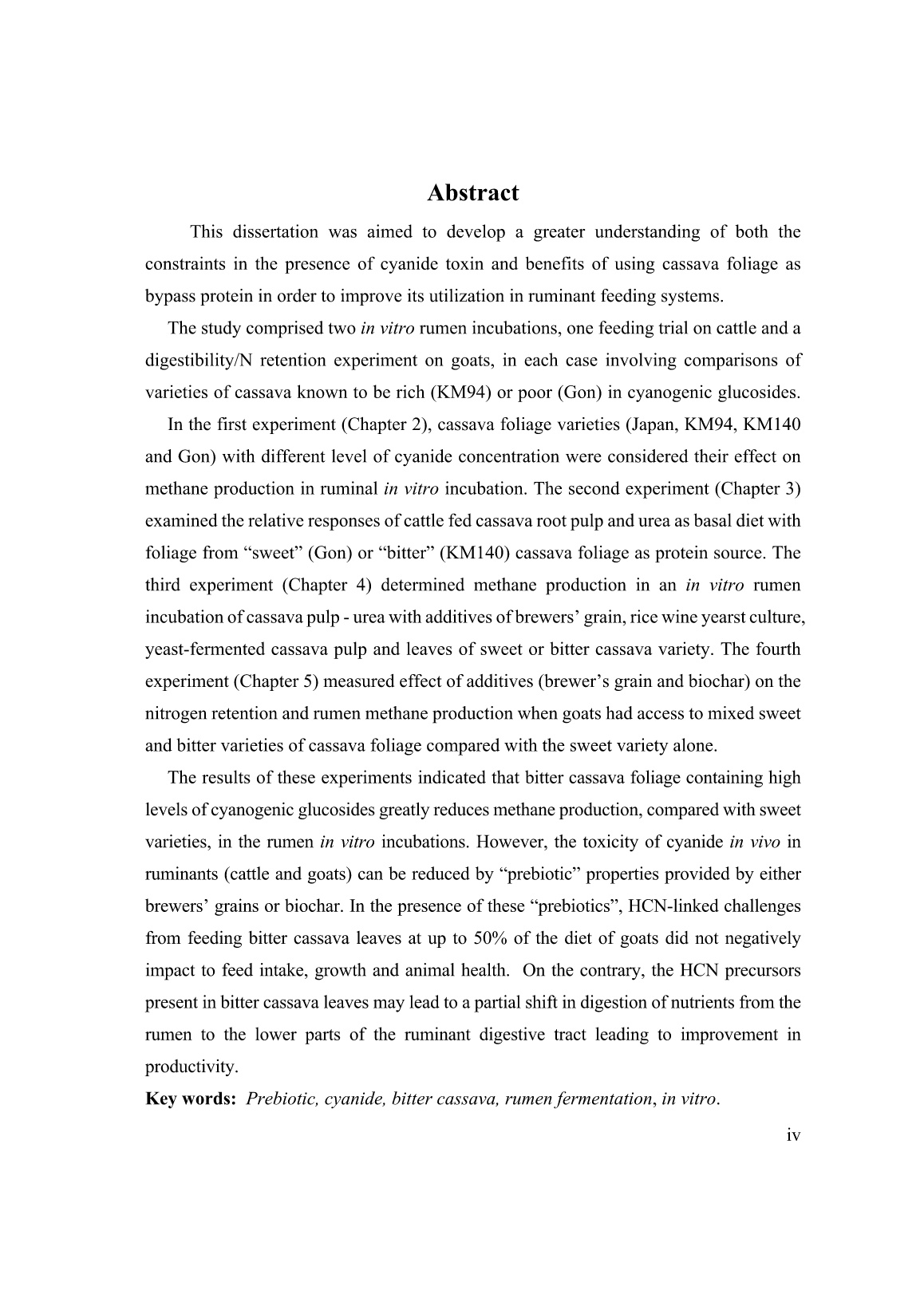
Trang 6

Trang 7
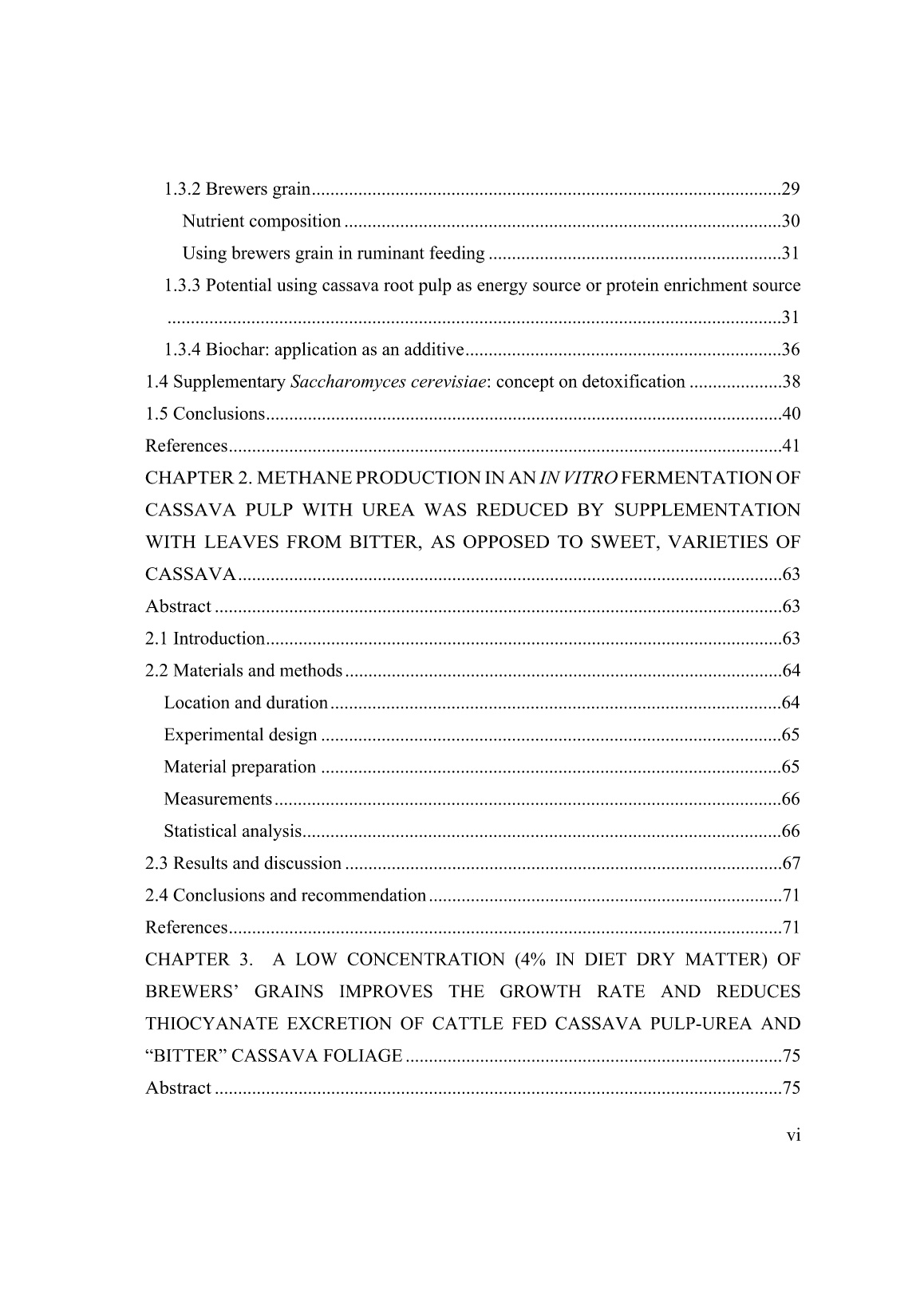
Trang 8

Trang 9
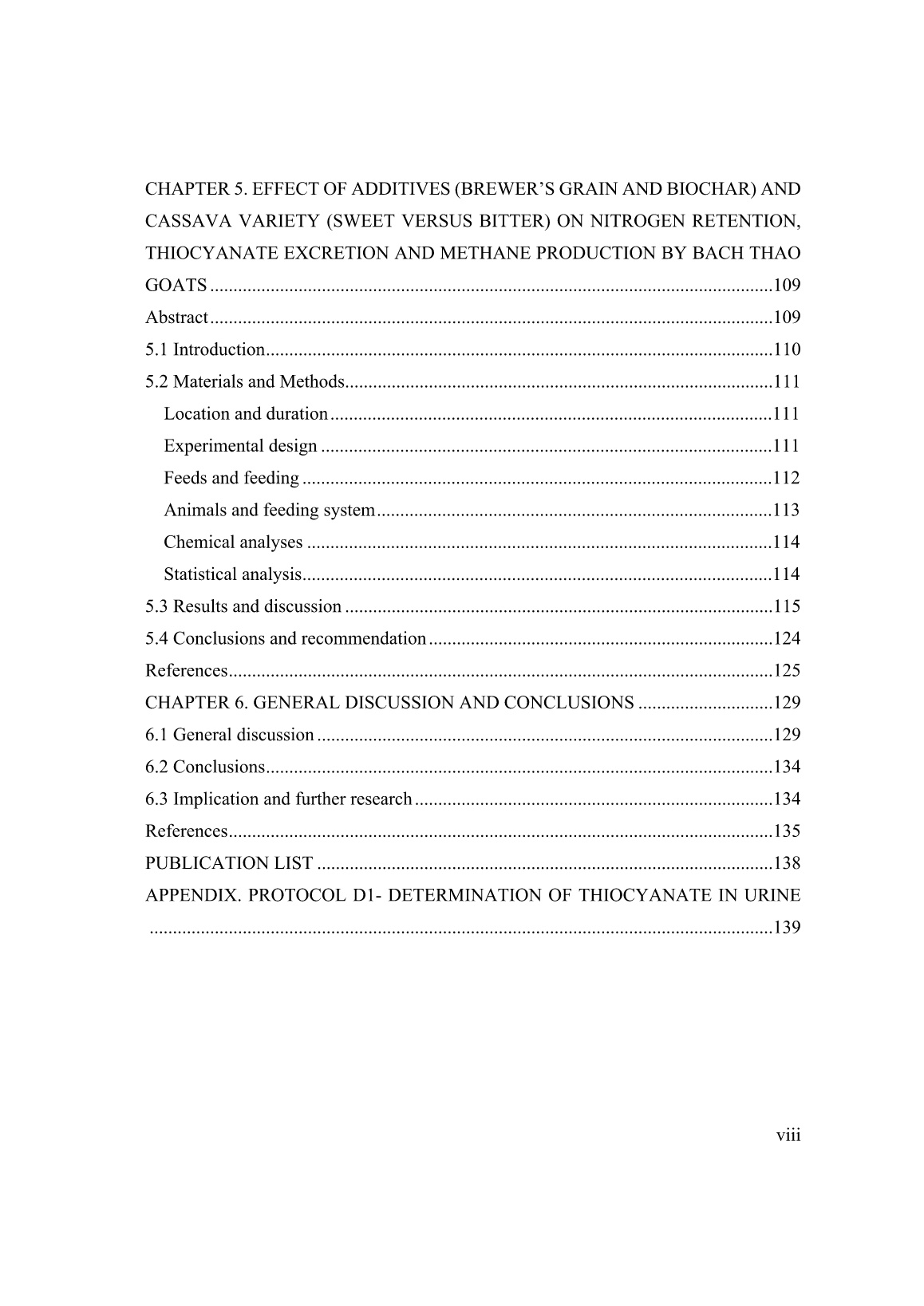
Trang 10
Tải về để xem bản đầy đủ
Bạn đang xem 10 trang mẫu của tài liệu "Luận án Synergic effect of cassava (manihot esculenta crantz) foliage, brewer’s grains, and biochar on methane production and performance of ruminants", để tải tài liệu gốc về máy hãy click vào nút Download ở trên.
Tóm tắt nội dung tài liệu: Luận án Synergic effect of cassava (manihot esculenta crantz) foliage, brewer’s grains, and biochar on methane production and performance of ruminants
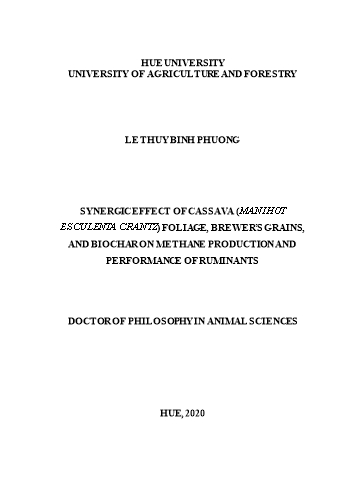
and Hart, M. R., 1985. Inhibition of methanogenesis and carbon metabolism in Methanosarcina sp. by cyanide. Journal of Bacteriology, 162, 67-71. Smith, O. B., 1988. A review of ruminant response to cassava-based diet. Cassava as livestock feed in Africa: Proceeding of the International Institute of Utilization of Cassava as Livestock Feed in Africa (IITA)/International Livestock Centre of Africa (ILCA). Hahn, S. K., Reynold, L., Egbunike, G. N. (Editors). Page 39-53. Sophal, C., Khang, D. N., Preston, T. R. and Leng, R. A., 2013. Nitrate replacing urea as a fermentable N source decreases enteric methane production and increases the efficiency of feed utilization in Yellow cattle. Livestock Research for Rural Development. Volume 25, Article #113. Retrieved July 24, 2019, from Sophea, Iv. and Preston, T. R., 2011. Effect of different levels of supplementary potassium nitrate replacing urea on growth rates and methane production in goats fed rice straw, mimosa foliage and water spinach. Livestock Research for Rural Development. Volume 23, Article #71. Sornyotha, S., Kyu, K. L., Ratanakhanokchai, K., 2010. An efficient treatment for detoxification process of cassava starch by plant cell wall-degrading enzymes. Journal of Bioscience and Bioengineering 109(1): 9-14. Southavong, S. and Preston, T. R., 2011. Growth of rice in acid soils amended with biochar from gasifier or TLUD stove, derived from rice husks, with or without biodigester effluent. Livestock Research for Rural Development. Volume 23, Article #32. Spring, P., Wenk, C., Connolly, A., Kiers, A., 2015. A review of 733 published trials on Bio-Mosđ, a mannan oligosaccharide, and Actigenđ, a second generation mannose rich fraction, on farm and companion animals. Journal of Applied Animal Nutrition 3, page 1–11. Stewart, P. S. and Franklin M. J., 2008. Physiological heterogeneity in biofilms. Nature Review Microbiology 6(3): 199-210. Suzuki, I., Tanaka, H., Kinoshita, A., Oikawa, S., Osawa, M., Yadomae, T., 1990. Effect of orally administered beta-glucan on macrophage function in mice. International Journal Immunopharmacology 12, page 675–684. Tacoma, R., Fields, J., Ebenstein, D. B., Lam, Y. W., Greenwood, S. L., 2017. Ratio of dietary rumen degradable protein to rumen undegradable protein affects nitrogen partitioning but does not affect the bovine milk proteome produced by mid-lactation Holstein dairy cows. Journal Dairy Science 100(9): 7246-7261. Tavendale, M. H., Meagher, L. P., Pacheco, D., Walker, N., Attwood, G. T., Sivakumaran, S., 2005. Methane production from in vitro rumen incubations with Lotus pedunculatus and Medicago sativa, and effects of extractable condensed tannin fractions on methanogenesis. Animal Feed Science and Technology, Volumes 123–124, Part 1, Pages 403-419, ISSN 0377-8401 Thammakiti, S., Suphantharika, M., Phaesuwan, T. and Verduyn, C., 2004. Preparation of spent brewer's yeast β‐glucans for potential applications in the food industry. International Journal of Food Science & Technology, 39: 21-29. doi:10.1111/j.1365-2621.2004.00742.x Thang, C. M., Ledin, I., Bertilsson, J., 2010. Effect of using cassava products to vary the level of energy and protein in the diet on growth and digestibility in cattle. ScienceDirect. Livestock Science. Volume 128, Issues 1–3, Pages 166-172 Theodoridou, K., Aufrốre, J., Andueza, D., Pourrat, J., Le Morvan, A., Stringano, E., Mueller-Harvey, I., Baumont, R., 2010. Effects of condensed tannins in fresh sainfoin (Onobrychis viciifolia) on in vivo and in situ digestion in sheep. Animal Feed Science and Technology 160(1): 23-38. Thuy Hang, L. T., Preston, T. R., Ba, N. X. and Dung, D. V., 2018. Digestibility, nitrogen balance and methane emissions in goats fed cassava foliage and restricted levels of brewers’ grains. Livestock Research for Rural Development. Volume 30, Article #68. Retrieved August 21, 2018. Thuy Hang, L. T., Preston, T. R., Leng, R. A. and Ba, N. X., 2018. Effect of biochar and water spinach on feed intake, digestibility and N-retention in goats fed urea-treated cassava stems. Livestock Research for Rural Development. Volume 30, Article #93. Retrieved August 25, 2018. Tokunaka, K., Ohno, N., Adachi, Y., Miura, N. N., Yadomae, T., 2002. Application of Candida solubilized cell wall beta-glucan in antitumor immunotherapy against P815 mastocytoma in mice. International Immunopharmacology, 2, page 59–67 Trinh Phuc Hao, Ho Quang Do, Preston, T. R. and Leng, R. A., 2009. Nitrate as a fermentable nitrogen supplement for goats fed forage-based diets low in true protein. Livestock Research for Rural Development. Volume 21, Article #10. Ulyatt, M. J., MacRae, J. C., Clarke, R. T. J. and Pearce, P. D., 1975. Quantitative digestion of fresh herbage by sheep. 4. Protein synthesis in the stomach. Journal of Agricultural Science, Cambridge 84, 453–458. Valadares, R. F. D., Broderick, G. A., Valadares Filho, S. C., Clayton, M. K., 1999. Effect of replacing alfalfa silage with high moisture corn on ruminal protein synthesis estimated from excretion of total purine derivatives. Journal of Dairy Science, 82:2686–2696. Valente, T. N. P., Lima, E. d. S., Santos, W. B. R. d., Cesỏrio, A. S., Tavares, C. J., Fernandes, I. L. and Freitas, M. A. M. d., 2016. Ruminal microorganism consideration and protein used in the metabolism of the ruminants: A review. Academic Journal 10(14): 456-464. Valverde, P., 1994. Barley spent grain and its future. Cerveza y Malta, 122, pages 7–26. Van Soest, J. P., 1982. Nutritional Ecology of the Ruminant. Second edition. Cornell University Press. Page 314. Download from https://books.google.com.vn/books?id=-mwUu6PL1UgC&printsec=frontcover&hl=fr&source=gbs_ge_summary_r&cad=0#v=onepage&q&f=false Van Soest, P. J., Conklin, N. L., Horvath, P. J., 1987. Tannins in foods and feeds. In: Proc Cornell Nutrition Conference for Feed Manufacturers, Cornell University, Ithaca, New York, USA, page 115-122. Vetvicka, V., Vannucci, L., Sima, P., 2014. The effects of β-glucan on pig growth and immunity. Open Biochemistry Journal, 8, page 89–93. Volman, J. J., Ramakers, J. D., Plat, J., 2008. Dietary modulation of immune function by β-glucans. Physiology Behavior, 94, page 276–284. Waghorn, G., 2008. Beneficial and detrimental effects of dietary condensed tannins for sustainable sheep and goat production – progress and challenges. Animal Feed Science Technology, 147, page 116–139. Wallace, R. J., 1996. The proteolytic systems of ruminal microorganisms. Annales de zootechnie, INRA/ ẫdition Diffusion Presse Sciences (EDP Sciences), 1996, 45 (Suppl1), page 301-308. (1996). The proteolytic systems of ruminal microorganisms. Wanapat, M., 1995. The use of local feed resources for livestock production in Thailand. Proceedings of the International Conference on Increasing Animal Production with Local Resources (Editor: Guo Tingshuang). China Forestry Publishing House, Ministry of Agriculture, China. Wanapat, M., 2003. Manipulation of Cassava Cultivation and Utilization to Improve Protein to Energy Biomass for Livestock Feeding in the Tropics. Asian-Australasian Journal Animal Science, volume 16, number 3: 463-472 Wang, C., Liu, J. X., Zhai, S. W., Lai, J. L., Wu, Y. M., 2008. Effects of rumen-degradable-protein to rumen-undegradable-protein ratio on nitrogen conversion of lactating dairy cows. Acta Agriculturae Scandinavica, Section A - Animal Science 58(2): 100-103. Wargiono, J. and Sudaryanto, B., 2002. Cassava leaves and forage crops for ruminant feed in the establishment of sustainable cassava farming systems in Indonesia. Cassava Research and Development in Asia: Exploring New Opportunities for an Ancient Crop. Proceeding of the Seventh Regional Workshop, Bangkok, Thailand Wargiono, J., Tuherkih E. and Sumaryono, 1982. Keragaan biomasa varietas ubikayu pada umur panen dan dosis pemupukan P berbeda pada tanah Ultisol (Cassava varieties performance at different levels of fertilizers applied and harvesting time in an Ultisol soil). Research Progress Report. Central Research Institute for Food Crops (CRIFC), Bogor, Indonesia. Waszkiewicz-Robak, B., 2013. Spent Brewer’s Yeast and Beta-Glucans Isolated from Them as Diet Components Modifying Blood Lipid Metabolism Disturbed by an Atherogenic Diet, Lipid Metabolism Rodrigo Valenzuela Baez, IntechOpen, DOI: 10.5772/51530. Available from: https://www.intechopen.com/books/lipid-metabolism/spent-brewer-s-yeast-and-beta-glucans-isolated-from-them-as-diet-components-modifying-blood-lipid-me Wattiaux, M. A., 1991. Protein metabolism in dairy cow. Dairy Essential. Babcock Institute for International Dairy Research and Development. University of Wisconsin-Madison. Download from Westendorf, M. L. and Wohlt, J. E., 2002. Brewing by-products: their use as animal feeds. Veterinary Clinics of North American: Food Animal Practice 18(2): 233-252. Westendorf, M. L. and Wohlt, J. E., 2002. Brewing by-products: their use as animal feeds. Veterinary Clinics of North American: Food Animal Practice 18(2): 233-252. Whitford, M. F., Teather, R. M., Forster, R. J., 2001. Phylogenetic analysis of methanogens from the bovine rumen. BMC Microbiology, 1: 5. Wikipedia. Biochar. https://en.wikipedia.org/wiki/Biochar Winders, T. M., Jolly-Breithaupt, M. L., Wilson, H. C., MacDonald, J. C., Erickson, G. E., Watson, A. K., 2019. Evaluation of the effects of biochar on diet digestibility and methane production from growing and finishing steers. Translational Animal Science 3(2): 775-783. Yafetto, L., 2018. Protein enrichment of cassava pulp by solid-state fermentation using Aspergillus niger. Studies in Fungi 3(1), 7–18. Yi, H., Juergens, M., and Jez, J. M., 2012. Structure of soybean β-cyanoalanine synthase and the molecular basis for cyanide detoxification in plants. The Plant cell, 24(6), 2696-706. Yiannikouris, A., Francois, J., Poughon, L., Dussap, C. G., Bertin, G., Jeminet, G., Jouany, J. P., 2004. Adsorption of zearalenone by beta-D-glucans in the Saccharomyces cerevisiae cell wall. Journal of Food Protection, 67, 1195–1200. Zlotnik, H., Fernandez, M. P., Bowers, B., Cabib, E., 1984. Saccharomyces cerevisiae mannoproteins form an external cell wall layer that determines wall porosity. Journal of Bacteriology 159, 1018–1026. CHAPTER 2. THE EFFECT OF SUPPLEMENTATION WITH “BITTER” OR “SWEET” VARIETIES OF CASSAVA LEAVES ON METHANE PRODUCTION IN AN IN VITRO INCUBATION Abstract The objective of the experiment is that comparing the effect of leaves from a sweet variety of cassava (Gon) and from bitter varieties (Japan, KM 94 and KM 140-1) on methane production, these cassava varieties were included as sources of protein in an in vitro fermentation of cassava root pulp supplemented with urea. Four treatments (Gon, Japan, KM 94 and KM 140-1) were designed in a completely randomized design (CRD) with four replications. Results showed that methane production was lower when leaves from bitter rather than sweet cassava were the protein source. There was a negative curvilinear relationship between the levels of HCN in the leaves and methane production. Condensed tannins were in the range from 2.0 to 2.6% (in DM) considered to favor escape of dietary protein from intestinal digestion and did not differ between sweet and bitter varieties. Ammonia concentration in the digesta after 24h fermentation was higher when leaves from sweet rather than bitter cassava was the protein source. Key words: condensed tannins, escape protein, HCN, ammonia, protein source 2.1 Introduction Recent industrial development of cassava root processing for extraction of starch released source of abundant cassava pulp. Cassava pulp and other by-products of cassava such as leaves, and stalk have potential feeding value for livestock. Cassava by-product needs to utilize in ruminant’s feeding system is cassava pulp, due to its negative fermentation impact lead to polluted environment. Cassa pulp represents approximately 10 to 15% of the original root weight (Khempaka et al. 2007). On a dry matter (DM) basis, cassava pulp contained 70% starch, 1.70% ash, 1.55% crude protein (CP), 27.8% crude fiber (CF) and 0.12% ether extract (EE) (Sriroth et al. 2000). The pulp is very low in protein; however, the foliage is high in CP with content of more than 20% in DM (Lukuyu et al. 2014). It was reported by Ffoulkes and Preston (1978) that fresh cassava foliage could replace soybean meal as the only protein source in a fattening diet for cattle based on ad libitum molasses-urea. Preston and Leng (2009) postulated that part of the cassava leaf protein had “rumen-escape” characteristics which helped to balance the microbial protein produced from the rumen fermentation of molasses supplemented with urea. Cassava products contain cyanogenic glucosides which liberate hydrocyanic acid (HCN) when enzymatically degraded. Cyanogenic glucosides exist as linamarin and lotaustralin in unbruised leaf (Nartey 1968). When the cellular structure is broken, the glucoside is exposed to extracellular enzymes such as linamarase which gives rise to toxic hydrocyanic acid. In studies on bio-digestion of cassava residues it was shown that the HCN liberated in the digestion process was toxic to methanogenic bacteria (Smith et al. 1985; Rojas et al. 1999). It is therefore postulated that a similar process could take place in the rumen of cattle fed cassava products, which could be an advantage as a strategy for reducing greenhouse gas emissions from ruminant animals. Sweet cassava variety are generally categorized into “sweet” varieties suitable for human consumption. The “bitter” varieties more appropriately used for industrial production of starch. It is understood that the ‘bitter” varieties are so-called because they have higher concentrations of cyanogenic glucosides making them potentially toxic to humans and animals. Establishing a feeding system from cassava by-product is limited the available information on its effectiveness and the impact of different level of HCN concentration in cassava foliage varieties on reduced methane production is not clear. Therefore, the hypothesis of this study was to test that methane production in an in vitro rumen fermentation would be reduced when urea-supplemented cassava root pulp was incubated with the leaves from bitter, rather than sweet, varieties of cassava. 2.2 Materials and methods Location and duration The in vitro experiments were conducted in the laboratory of Nong Lam University, Ho Chi Minh city, Viet Nam, in December 2014. Experimental design The four treatments in a completely randomized design (CRD) were the leaves of four cassava varieties (Gon, Japan, KM94 and KM 140-1) with four replications. The substrates were cassava pulp and urea. The leaves were added to provide an overall level of 12.8% crude protein in substrate DM. Table 2.1 Composition of the substrates Gon Japan KM94 KM 140-1 DM basis, % Cassava pulp 73.1 73.1 73.1 73.1 Cassava leaves 25 25 25 25 Urea 1.8 1.8 1.8 1.8 Fresh basis, g Cassava pulp 10.4 10.4 10.4 10.4 Cassava leaves 12.3 9.8 12.2 13.5 Urea 0.216 0.216 0.216 0.216 A simple in vitro system was used based on the procedure reported by Inthapanya et al. (2011). Material preparation The cassava leaves were from plants five months old growing in different locations in Cam My, Dong Nai province. Leaves (without petioles) were selected at a point approximately one third of the height of the plant measured from the top. They were stored in plastic bags to avoid loss of moisture. In the laboratory, the fresh leaves were chopped into small pieces and then ground (1mm sieve). Dry cassava pulp was taken from the Wuson starch factory, Binh Phuoc Province. Rumen fluid was taken from a Holstein male animal immediately after it was slaughtered at the local abattoir. Rumen fluid was filtered directly through 2 layers of cloth to contain in thermal flask to keep warm, then moving quickly to laboratory for mixing. The 12 grams of substrates (Table 2.1) were mixed with 0.24 liters of rumen fluid and followed by 0.96 liters of buffer solution (Table 2.2). This mixture was contained in the fermentable bottle, gassed with carbon dioxide, and incubated in a water bath at 38°C for 24h. Table 2.2 Ingredients in buffer solution Ingredients CaCl2 NaHPO4.12H2O NaCl KCl MgSO4.7H2O NaHCO3 Cysteine g/liter 0.04 9.3 0.47 0.57 0.12 9.8 0.25 Source: Tilley and Terry (1963) Measurements The gas volume was measured by water displacement from the receiving bottle suspended in water. The bottle was calibrated at intervals of 50ml. The methane percentage in the gas was measured with a Crowcon meter (Crowcon Instruments Ltd, UK). The DM and crude protein contents of the substrates were determined according to AOAC (1990) methods. Ammonia was analysed in the filtrate after separating the solids using a cloth filter. HCN was determined by titration with AgNO3 after boiling the sample in KOH to concentrate the HCN. Tannin was analyzed by the Lowenthal method consisting of boiling the leaves in 0.1N H2SO4, adding indigo dye and titrating with potassium permanganate. Statistical analysis The data were analysed with the general linear model (GLM) option in the ANOVA program of the Minitab software (Minitab 2000). Sources of variation were treatments, and error. The regression model: Yij = μ + Ti + eij Y is the observation random variable representing the response for cassava varieties. à is the overall mean. Ti term the treatment effect (i=1-4). eij is random error. 2.3 Results and discussion Results Chemical composition of the substrate The cassava leaves contained a high level of crude protein (27.5-31.8% CP in DM); the cassava pulp had less than 3% CP in DM (Table 2.3). The starch residue in cassava pulp is abundant, therefore, it was used as an energy source effectively in ruminant feeding system by adding non-protein source such as urea (Phanthavong et al. 2016). The concentration of HCN in Gon variety is lowest among varieties, therefore, it does not taste bitter like the rest of three cassava varieties (Japan, KM94 and KM140-1). In cassava field, Gon variety is called “sweet” cassava and is grown for human consumption. Japan, KM94 and KM140-1 varieties was called “bitter” varieties and appropriately used for industrial production of starch. Table 2.3 Chemical composition of the ingredients in the substrate Gon Japan KM 94 KM 140-1 Pulp Dry matter, % 24.4 30.6 24.6 22.2 84.4 Crude protein, % in DM 32.1 27.5 30 29.7 2.5 Starch, % in DM - - - - 53.5 (*) HCN concentration, mg/kg DM 339 419 570 826 <5 (*) Data taken from Khempaka et al. (2009) Gas production, ammonia concentration and DM mineralized According to Makkar (2004) dry matter solubility is to evaluate the solubility of both fermentable matter and non-fermentation matter, while gas production only measured fermentable products but did not contribute by soluble non-fermentation matter. Gas production after 24 hours fermentation did not differ among the treatments (Table 2.4) reflected the extent of rumen degradation is the same among cassava varieties. But the percentage of DM mineralized (or DM solubilized) was lower in Gon cassava variety than in the rest of three varieties (Japan, KM94 and KM140-1) among which there were no differences. Ammonia concentration in the fermentation medium at the end of incubation was higher for Gon cassava than for other varieties, although, the condensed tannin is no significant difference among cassava varieties (Table 2.4). Table 2.4 Mean values for gas production in 24 hours, DM mineralized and ammonia in an in vitro rumen fermentation. Gon Japan KM 94 KM 140-1 SEM p value Gas, ml/24h 425 520 515 458 39.6 0.300 DM mineralized, % 26.6a 33.6 ab 32.6 ab 38.2 b 2.5 0.044 Ammonia mg/L 197 175 177 170 12.3 0.45 ab Mean values in rows without common letter are different at p<0.05 Methane, HCN and condensed tannin
File đính kèm:
 luan_an_synergic_effect_of_cassava_manihot_esculenta_crantz.docx
luan_an_synergic_effect_of_cassava_manihot_esculenta_crantz.docx 1. DECLAREATION-Phuong.docx
1. DECLAREATION-Phuong.docx 3. REQUEST FOR DISSERTATION DEFENSE-Phuong.docx
3. REQUEST FOR DISSERTATION DEFENSE-Phuong.docx 4. New contribution of thesis-Phuong.docx
4. New contribution of thesis-Phuong.docx 5. Declaration to confirm data in CD-Phuong.docx
5. Declaration to confirm data in CD-Phuong.docx 6. Short summary of dissertation-Eng &Viet-Phương.docx
6. Short summary of dissertation-Eng &Viet-Phương.docx 7. List of publication-Phuong.docx
7. List of publication-Phuong.docx 8. Eng-summary of thesis-Phuong.docx
8. Eng-summary of thesis-Phuong.docx 8. Viet-summary of thesis-Phuong.docx
8. Viet-summary of thesis-Phuong.docx 10. Explanation of revised thesis-Phuong.docx
10. Explanation of revised thesis-Phuong.docx 11. Abstract -Eng and Viet-Phuong.docx
11. Abstract -Eng and Viet-Phuong.docx

